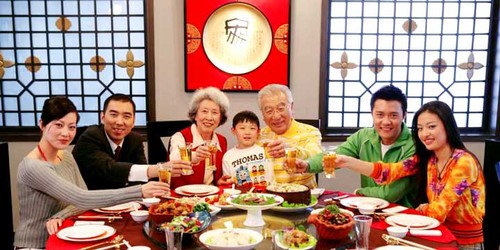 A Chinese family’s reunion dinner. (Photo: topchinatravel.com) A Chinese family’s reunion dinner. (Photo: topchinatravel.com)
|
Bao Tram: Thank you for joining our show today, Duo.
Qing Duo: Hello Tram, thank you for having me here to share about Spring Festival in China. For both Chinese and Vietnamese, this is the most important festival of the year.
Bao Tram: Because China is so vast, New Year customs may vary in different areas, I guess.
Qing Duo: Yes, in different areas of China, people have their distinct ways to celebrate the most important festival of the year, especially between north and south of China. The differences can be seen in food, decorations, gifts, and activities.
For example, in northern China, people usually eat dumplings on Lunar New Year's Eve. It is called Jiaozi in Chinese, which means the turn of a new year. People consider the shape of dumplings a symbol of wealth or fortune. Dumplings are shaped like an ancient Chinese gold ingot.
People in the south are accustomed to eating rice cakes, which we called Niangao. Niangao are made of glutinous rice flour. They have an implied meaning that people get promoted to a higher position year after year. In Guangdong, Guangxi, and Fujian provinces, people eat rice cakes in a hotpot with sea food, meat, and vegetables.
For New Year decorations, in the northern provinces, the custom of pasting paper shapes and Lunar New Year pictures on windows has been retained. In the south, however, paper cuttings and New Year pictures are hardly to be seen. Instead people use pots of kumquats for decoration.The yellow color symbolizes wealth and an abundant harvest.
Apart from visiting relatives on Lunar New Year Day, which happens all over China, there are many differences in activities between northern and southern China.
In Beijing, my hometown, temple fairs are held on the first day of the New Year. People go there with family members and friends to see folk performances and eat New Year snacks. In the south, there are lantern displays. And in Guangzhou, flower fairs for Lunar New Year can be seen in city lots and cultural spots. People go there to buy flowers or ornamental trees for relatives and friends to express their best wishes for the new year. As you can see, there are different customs all over China.
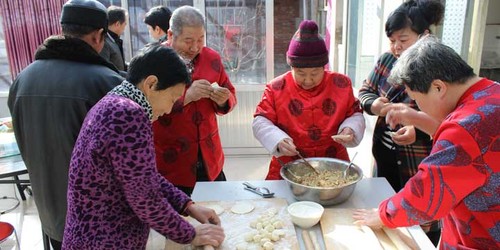 Members of a Chinese family make dumpling together. (Photo: topchinatravel.com) Members of a Chinese family make dumpling together. (Photo: topchinatravel.com)
|
Bao Tram: Have Chinese people preserved traditional ways of celebrating the New Year? Or have there been changes since the internet boom?
Qing Duo: We have to admit that the development of the internet has totally changed our life. In particular the popularization of electronic payment in China has completely changed the way we shop.
When I was a little girl, before a Spring Festival, my mother and I would go to the market to pick out New Year decorations and food. But in recent years, she has bought all those things online. I think the internet has brought people together. Cell phones these days have become an organ of our body, at least in my generation. But at the same time, it has also reduced our personal space. When we get together with our families, we tend to forget the people in front of us. Instead, we all look at our cell phones and talk to others through the screen. I really hope everyone will put down their cell phone and chat with their relatives during the next family reunion.
Bao Tram: The China Outbound Tourism Research Institute reported that in 2020, for the first time, more than seven million Chinese registered to travel abroad during Lunar New Year, compared to 6.3 million the previous year. Is traveling abroad during the holiday becoming a trend in China?
Qing Duo: That's right. Spring Festival usually involves a week off. Traditionally, it’s a time for family reunions, but nowadays young people are increasingly eager to use the holiday to travel. In fact, it's not just China. Many of my Vietnamese friends have told me they also like to go travelling instead of staying at home during the Spring Festival holiday.
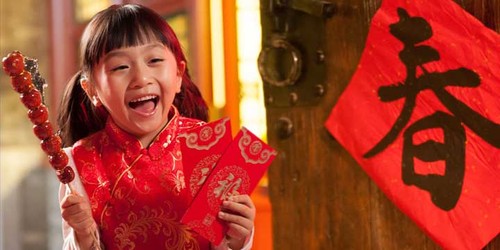 Giving red envelops containing lucky money is a tradition during the Lunar New Year Festival. (Photo: topchinatravel.com) Giving red envelops containing lucky money is a tradition during the Lunar New Year Festival. (Photo: topchinatravel.com)
|
Bao Tram: For both Vietnam and China, giving red envelopes containing lucky money is an old Lunar New Year custom. What’s the custom now in your country?
Qing Duo: In both China anh Vietnam, almost everyone knows the tradition of giving red envelopes containing cash. The tradition of giving red envelopes has evolved in the smartphone age, with many people using social media apps like WeChat, plus Alipay, to gift small sums of cash to their friends as a goodwill gesture. It’s fine if the amount is tiny when it comes to lucky money sent though smartphone apps. It’s mostly for fun. In recent years, sending red envelopes through Wechat and Alipay has become a popular way of wishing people a Happy New Year in China!
Bao Tram: How much is usually given?
Qing Duo: Traditional red envelopes are given to children by their elders, usually ranging from hundreds to thousands of Yuan. But WeChat Lucky Money doesn’t need to give that much, only a few Yuan will be fine, WeChat Lucky Money can only send 200 yuan at most which is about 30 dollars.
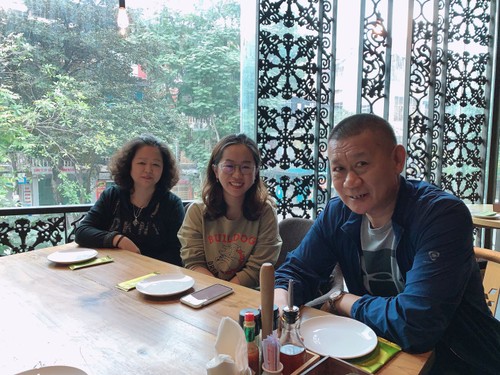 Qing Duo (C) and her parents at a restaurant in downtown Hanoi during 2020 Lunar New Year. (Photo credit: Qing Duo) Qing Duo (C) and her parents at a restaurant in downtown Hanoi during 2020 Lunar New Year. (Photo credit: Qing Duo) |
Bao Tram: You have experienced the Lunar New Year festival in Vietnam. What are the similarities and differences with China?
Qing Duo: I was born and raised in Beijing. Last year was the first time I spent Spring Festival in Hanoi, which was a very special experience. My parents came here to visit me and they were also excited about celebrating Spring Festival in another country. Before Lunar New Year's Eve, we went to the Old Quarter in Hanoi and bought some New Year paintings and lanterns. I found that our two countries have the same tradition of using the color red to celebrate the new year. A Vietnamese friend bought me a peach flower branch and told me that every Vietnamese family decorates their home with a peach flower on this occasion. It was very beautiful. We also tried Banh Chung, which in China we call Zongzi. This is an indispensable delicacy for Vietnamese during the Lunar New Year. In China, we usually eat Zongzi during the Dragon Boat Festival, while in Vietnam it is during the Spring Festival.
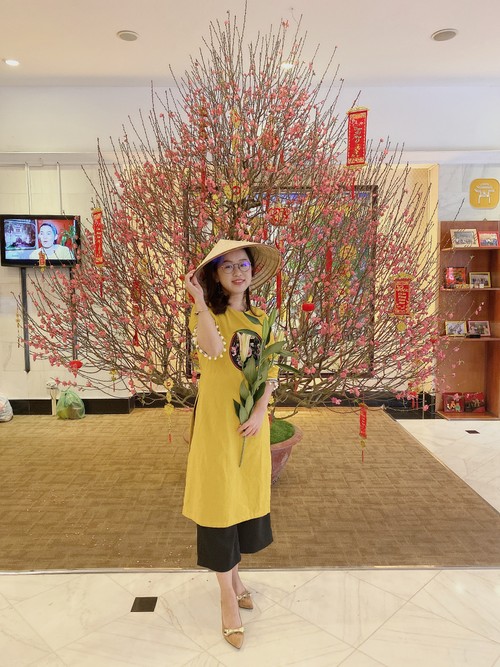 Qing Duo in the Vietnamese traditional dress. (Photo credit: Qing Duo) Qing Duo in the Vietnamese traditional dress. (Photo credit: Qing Duo)
|
Both Hanoi and Beijing are busy cities, but during the Spring Festival, they suddenly get quiet. Restaurants and shops in Hanoi are mostly closed. I want to say that I really enjoyed Hanoi like this. It’s like seeing another side of the city. It’s quite different. My mother said that she wanted to spend her Spring Festival holiday in Vietnam again this year, but due to the COVID-19 epidemic, it was impossible. I really hope the epidemic will be over soon and I can reunite with my family. It would be better if I could take my parents travelling in Vietnam.
Bao Tram: Thank you so much, Duo, for joining us today and telling us how Chinese people celebrate the Spring Festival. I hope you will have a joyful Lunar New Year holiday, your second in Vietnam.
Qing Duo: Thank you, Tram, I really enjoyed talking with you. I would like to take this opportunity to wish all Vietnamese friends a happy New Year.